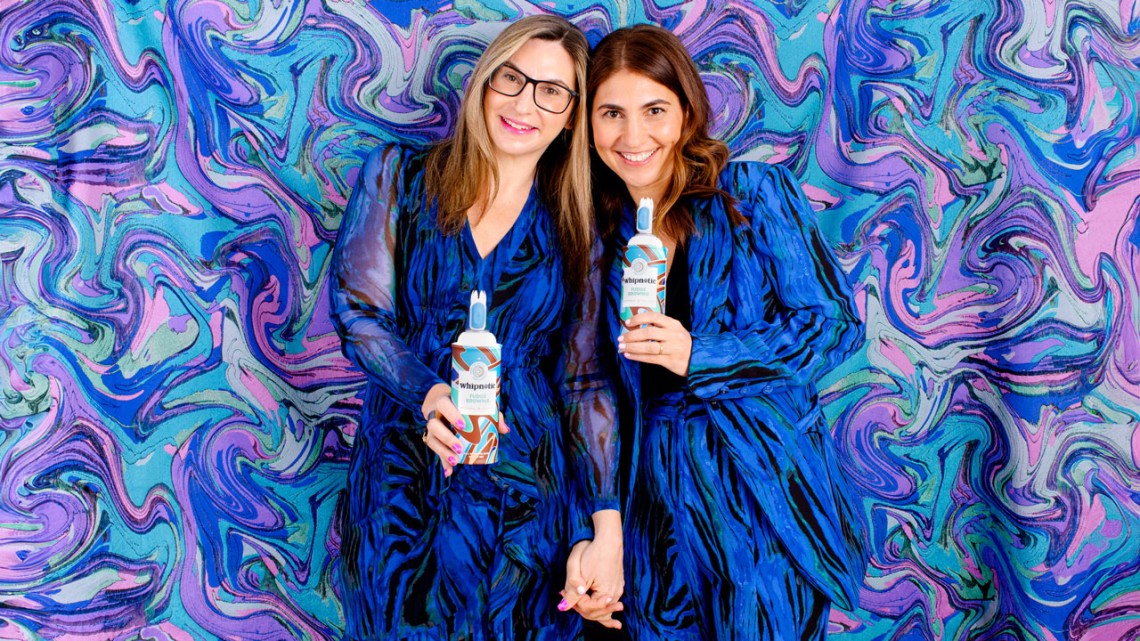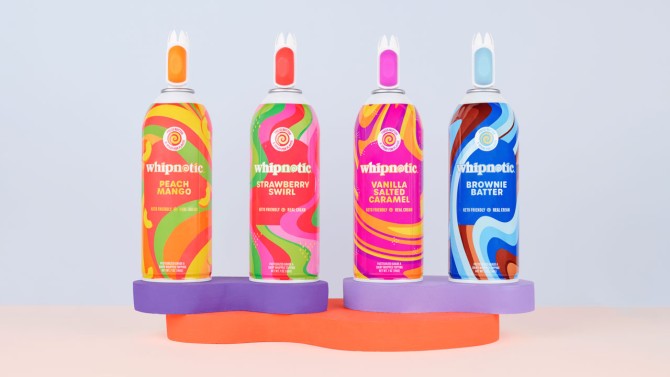
Tracy Luckow ’99, left, and her sister Lori Gitomer ’01 created Whipnotic, a line of swirly, flavored whipped creams.
Whipped cream disruptor to speak at entrepreneurship celebration
By Laura Reiley, Cornell Chronicle
Whipped cream in a can has three big days: Thanksgiving (pie topper), Christmas (more pie) and Mother’s Day (to gussy up Mom’s breakfast in bed). Otherwise, the aerosol cylinder usually sits forlornly in the fridge door with its condiment brethren.
But in 2019, Tracy Luckow ’99 and her sister Lori Gitomer ’01 decided to think bigger. That’s when they dreamed up Whipnotic, a line of swirly, flavored whipped creams, from fudge brownie to peach mango, with a novel button-touch nozzle system.
Whipnotic debuted in 2022 and has now sold 150,000 cans in more than 1,000 stores across 28 states – despite the challenges of the pandemic, food inflation and a whole lot of lactose leeriness. Luckow will share the peaks and valleys of her entrepreneurial journey on April 12 at Entrepreneurship at Cornell’s Celebration, a two-day conference held every spring that brings together students, alumni, faculty, staff and community participants.
Highlights include interactive panels and fireside chats with company founders, eLab Demo Day, Student Business of the Year recognition, the BenDaniel Venture Challenge and recognition of the 2024 Entrepreneur of the Year.
“We want all the students and Celebration participants to come away super energized about entrepreneurship and about who they met and the connections they made,” said Zach Shulman ’87, J.D. ’90, and director of Entrepreneurship at Cornell.
“When Tracy was a student here, she wasn’t focused on entrepreneurship. She got the start-up bug later in life, which isn’t unusual. We want to show students that entrepreneurship comes in different flavors, and is something they can do at any point in their lives,” Shulman said.
For Luckow and her sister, the key to entrepreneurial success was finding a category ripe for disruption. Reddi-wip had been king of canned whipped cream nearly since its invention in 1948, with just a handful of store brands encroaching.
“Nothing had been challenged and there had been no innovation in the category,” Luckow said. “Meanwhile, pre-pandemic we had seen all these baristas swirling flavors into coffees, and even in pancake restaurants they were putting flavored syrups into whipped cream. We thought, wouldn’t it be fun to bring some of that excitement and fun into grocery? It led us down a big rabbit hole of invention.”
They brainstormed: vanilla salted caramel, fudge brownie, strawberry swirl and peach mango, all with colorful bands striping the clouds of sweet cream.
They worked with the New York State Center of Excellence for Food and Agriculture (COE) to perfect the button-touch nozzle, to identify a manufacturer for a filling device and to make sure the product complied with all food safety requirements.
“Our first ‘phone a friend’ was Cornell. Faculty were helpful in guiding us through process and in how to protect our idea – they recommended we immediately reach out to patent lawyers,” said Luckow, who has a Ph.D. in food science. She says she could have taken a more traditional career path, as a corporate product developer.
“But my curiosity pushed me to keep asking questions,” she said, adding that she aims to talk about her background and unconventional career trajectory with entrepreneurship students during her April 12 talk. “Many of the students in the classroom were me 25 years ago. I remember what it’s like to be sitting in that classroom and listening to people,” she said.
Another key to Whipnotic’s growth, Luckow said, is what she referred to as the product’s “incrementality.” She explained that this is growth that can be attributed to new marketing strategies, things that go beyond a product category’s existing market.
“For other brands in whipped cream, it’s often purchased three times a year. Without interfering with the normal stream of the category, our product is purchased at slightly different times,” she said.
The deep-red ribbon in the strawberry swirl was a go-to for Valentine’s Day. The fruity flavors lend themselves to summer berry and stone fruit season. And salt caramel and brownie batter make logical add-ons for lattes and other coffee drinks.
Images of brightly colored dessert toppers on visual social media platforms like Instagram and TikTok may also have spurred sales. Other whipped cream brands have begun paying attention, Luckow said, buying their products and swinging by their booth at trade shows to ogle their aerosol cans (the juice or flavoring agent is housed in the button at the top, while the cannister is filled with plain sweetened cream).
One seismic cultural shift has spooked much of the food world in the past year: The rise of the diabetes and weight-loss drugs known as GLP-1 agonists have led to predictions that the market for obesity drugs will reach $77 billion by 2030 and that as a consequence categories like fast food, savory snacks and sweet treats will see a marked diminution in sales.
Luckow sees this as a potential win for Whipnotic, which is 15 calories per serving and, according to her, provides the sensory experience of having ice cream without spiking blood sugar.
“It’s time now. This will push transformation,” she said. “This will make our food system better. Challenges breed innovation.”
Media Contact
Adam Allington
Get Cornell news delivered right to your inbox.
Subscribe

